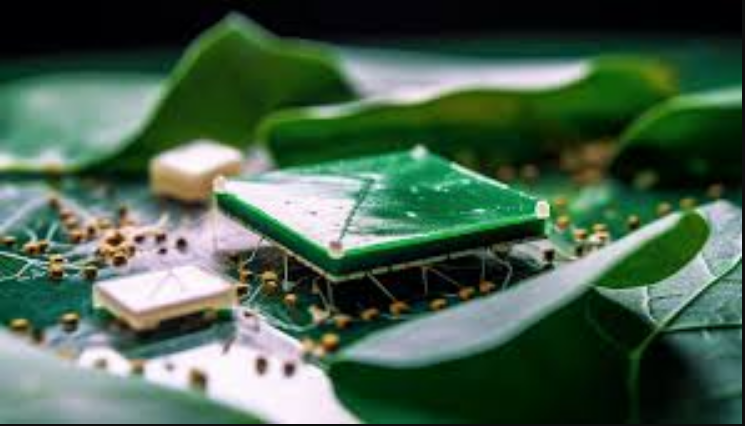The relentless march of technology brings undeniable benefits, but it also generates a significant burden: electronic waste, or e-waste. With ever-shorter product lifecycles and a growing dependence on electronic devices, e-waste is the world’s fastest-growing waste stream according to the United Nations Environment Programme https://www.unep.org/. This poses a serious threat to our environment and human health, as improper e-waste disposal can leach harmful toxins into soil and water.
Biodegradable electronics offer a glimmer of hope in this scenario. These are electronic devices designed to decompose naturally after their designated lifespan. This emerging field holds immense potential to revolutionize the electronics industry and mitigate the e-waste crisis.
Understanding Biodegradable Electronics
Biodegradable electronics are a revolutionary concept that promises to reshape the electronics industry and tackle the growing e-waste crisis. These electronics are crafted from materials that microorganisms like bacteria and fungi can break down naturally at the end of their lifespan. Let’s delve deeper into the world of biodegradable electronics, exploring the materials they’re made from, the design considerations, and how they differ from traditional electronics.
Material Marvels: Building Blocks of Biodegradation
The foundation of biodegradable electronics lies in two main categories of materials:
Natural Polymers:
Nature offers a treasure trove of biodegradable polymers that scientists are actively exploring. Here are some key examples:
Cellulose: This abundant and renewable resource, found in wood and plant cell walls, holds immense potential. Scientists are developing methods for processing cellulose. These methods will turn cellulose into films and membranes suitable for use as substrates for electronic components.
Chitosan: Derived from the shells of shrimp and other crustaceans, chitosan boasts excellent biocompatibility and film-forming properties. It can be used as a dielectric layer in capacitors or blended with different materials to create biodegradable conductors.
Silk: This naturally occurring protein fiber, known for its strength and biocompatibility, is being explored for various applications. Silk can be used as a substrate for flexible electronics or even as a bioresorbable coating for temporary implants.
Synthetic Polymers:
Scientists are also engineering synthetic polymers that can degrade under specific environmental conditions. These offer several advantages:
Tailored Degradation: Researchers can control the degradation rate by carefully designing the polymer structure. This allows for customization based on the desired lifespan of the electronic device.
Enhanced Properties: Scientists engineer synthetic polymers to possess specific electrical properties that are difficult to achieve with natural polymers alone.
Beyond Materials: Design and Fabrication for Biodegradability
Developing biodegradable electronics goes beyond just using biodegradable materials.
Replacing Traditional Components: Traditional electronics rely heavily on non-biodegradable materials like silicon and certain metals. Researchers are exploring alternatives like organic semiconductors or entirely new device architectures that don’t require these components.
Biocompatible Interfaces: For applications like medical implants, the biocompatibility of the electronics is crucial. This involves the usage of materials and design considerations to minimize potential negative interactions with the body’s tissues.
Sustainable Processing Techniques: Fabrication methods for biodegradable electronics need to be environmentally friendly. Researchers are exploring techniques that minimize solvent use and energy consumption during manufacturing.
Potential Impact of Biodegradable Electronics

The potential impact of biodegradable electronics extends beyond simply offering a greener disposal option. Widespread adoption of this technology can reshape the electronics industry and create a more sustainable future. Here’s a closer look at the multifaceted benefits biodegradable electronics can bring:
Reduced Landfill Burden:
Traditional electronics often end up in landfills, where decomposing takes hundreds of years. Landfills are already overflowing, and the influx of e-waste is magnifying the problem. Biodegradable electronics can decompose naturally in a controlled environment like a compost facility. This significantly reduces the amount of electronic waste clogging landfills and frees up valuable space for other types of waste.
Environmental Safeguards:
Improper disposalof traditional electronics can lead to the leaching of harmful toxins like lead, mercury, and brominated flame retardants into the environment. These toxins can contaminate soil and water sources, posing a serious threat to human health and ecological systems. Biodegradable electronics break down into harmless byproducts, minimizing the risk of environmental contamination.
Resource Conservation:
The manufacturing of traditional electronics often relies on the extraction of virgin resources like rare earth metals. This process can be environmentally destructive and lead to resource depletion. Biodegradable electronics present an opportunity to move away from this reliance. By utilizing renewable resources like cellulose and chitosan, and potentially even recycled materials, biodegradable electronics can promote a more sustainable and circular economy for the electronics industry.
Reduced Carbon Footprint:
The production of traditional electronics, on the other hand, involves significant energy consumption, contributing to greenhouse gas emissions. Biodegradable electronics offer an opportunity to reduce this environmental impact. Using renewable resources and potentially less energy-intensive fabrication processes can lead to a lower carbon footprint for the entire life cycle of the device.
Sustainable Product Lifecycles:
The electronics industry’s design strategy of planned obsolescence, which intentionally shortens a device’s lifespan, significantly drives e-waste generation. Biodegradable electronics can disrupt this cycle. By designing electronics with a predetermined lifespan that aligns with their biodegradability, we can encourage a more sustainable approach to product lifecycles. This would involve focusing on repairability, upgradability, and designing for ease of disassembly and composting at the end of the device’s life.
Applications of Biodegradable Electronics
Biodegradable electronics transcend the realm of just sustainable disposal. Their unique properties open doors to innovative applications across various sectors, particularly those with short lifespans or requiring implantation within the human body. Let’s delve deeper into some of the most exciting potential applications:
Revolutionizing Medical Care with Biodegradable Implants:
Dissolvable Drug Delivery Systems: Biodegradable electronics can be instrumental in creating implantable devices that deliver precise doses of medication directly to the target site within the body. Once the medication is depleted, the device itself biodegrades, eliminating the need for a second surgery to remove it. This can significantly improve patient comfort, reduce recovery times, and minimize risks associated with additional procedures.
Biodegradable Sensors for Vital Sign Monitoring: Imagine implantable sensors that continuously monitor vital signs like heart rate, blood pressure, or blood sugar levels. These sensors could be fabricated from biodegradable materials, allowing them to function for a predetermined period and then naturally break down within the body. This would offer a minimally invasive way to track a patient’s health and provide real-time data to medical professionals.
Bioresorbable Scaffolds for Tissue Regeneration: Scientists are integrating biodegradable electronics into scaffolds to aid tissue regeneration. These scaffolds could provide temporary structural support and deliver electrical stimulation to promote cell growth and healing. Once the tissue has regenerated, the biodegradable electronics would naturally decompose, leaving healthy new tissue behind. This holds immense potential for applications in bone repair, nerve regeneration, and other areas of regenerative medicine.
Environmental Monitoring Gets Greener with Biodegradable Sensors:
Remote Environmental Monitoring: Scientists are deploying biodegradable sensors in remote or harsh environments like deserts, rainforests, or underwater locations to collect vital environmental data. These sensors can be designed to monitor factors like temperature, humidity, and pollution levels, or even track wildlife movement. Since they biodegrade after a set time, there’s no need for retrieval missions, reducing the logistical challenges and environmental impact of traditional monitoring methods.
Biodegradable Biosensors for Sustainable Agriculture: Disposable smart devices, like biodegradable patches containing health monitors or even temporary smart tattoos with integrated circuits, hold immense potential. In fact, researchers are developing biodegradable biosensors that can be embedded in soil or plants to monitor nutrient levels, and moisture content, and even detect the presence of pathogens. These sensors would provide valuable data for precision agriculture practices, optimizing resource use and minimizing environmental impact. Furthermore, after fulfilling their purpose, the sensors would naturally biodegrade within the environment, eliminating the need for extra waste disposal.
Wearable Tech Goes Green: Biodegradable Alternatives for Everyday Devices:
Eco-Friendly Fitness Trackers: The ever-growing popularity of wearable fitness trackers has also raised concerns about e-waste generation. Biodegradable alternatives could be developed using compostable materials. These trackers could monitor heart rate, activity levels, and other health metrics, and then biodegrade at the end of their lifespan, reducing the environmental footprint of this booming industry.
Disposable Smart Devices with Biodegradable Circuits: Disposable smart devices, like biodegradable patches containing health monitors or even temporary smart tattoos with integrated circuits, hold immense potential. In fact, we can design these devices for short-term health monitoring or specific applications, and they will decompose naturally after use.
Challenges and the Road Ahead
While biodegradable electronics hold immense promise, there are still challenges to overcome before widespread adoption becomes a reality.
Material Development: Despite significant progress, developing biodegradable materials with the desired electrical properties, mechanical strength, and degradation rates for specific applications remains an ongoing research focus.
Device Performance: Biodegradable electronics currently may not match the performance and functionality of traditional electronics in all aspects. Continued research is needed to bridge this gap.
Composting Infrastructure: A robust composting infrastructure can actively handle these electronics for complete biodegradation.
Research institutions, universities, and private companies are making significant strides in advancing biodegradable electronics, despite the challenges. As research progresses and collaborations intensify, we can expect to see significant breakthroughs in material development, device performance, and infrastructure development to support large-scale adoption.
Conclusion
Biodegradable electronics represent a paradigm shift in how we design and use electronic devices. By harnessing the power of nature, this technology offers a compelling solution to the mounting e-waste crisis. While challenges remain, the potential benefits for the environment and human health are undeniable. As research and development continue, biodegradable electronics have the potential to usher in a new era of sustainable electronics, paving the way for a greener future.




